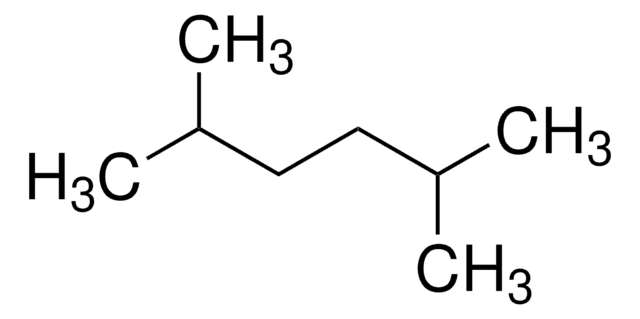244414
1-Heptyne
98%
Synonym(s):
1-n-Heptyne, Amylacetylene, Pentylacetylene
Sign Into View Organizational & Contract Pricing
All Photos(1)
About This Item
Linear Formula:
CH3(CH2)4C≡CH
CAS Number:
Molecular Weight:
96.17
Beilstein:
1733518
EC Number:
MDL number:
UNSPSC Code:
12352100
eCl@ss:
39010410
PubChem Substance ID:
NACRES:
NA.22
Recommended Products
vapor pressure
93.1 mmHg ( 37.7 °C)
Quality Level
Assay
98%
form
liquid
refractive index
n20/D 1.408 (lit.)
bp
99-100 °C (lit.)
mp
−81 °C (lit.)
density
0.733 g/mL at 25 °C (lit.)
SMILES string
CCCCCC#C
InChI
1S/C7H12/c1-3-5-7-6-4-2/h1H,4-7H2,2H3
InChI key
YVXHZKKCZYLQOP-UHFFFAOYSA-N
Looking for similar products? Visit Product Comparison Guide
Related Categories
General description
The hydrogenation of 1-heptyne with palladium, platinum and ruthenium supported on activated carbon as catalysts, was studied.
Application
1-Heptyne was used in the synthesis of (6Z,10E,12Z)-octadeca-6,10,12-trienoic acid and (8Z,12E,14Z)-eicosa-8,12,14-trienoic acid.
Signal Word
Danger
Hazard Statements
Precautionary Statements
Hazard Classifications
Flam. Liq. 2
Storage Class Code
3 - Flammable liquids
WGK
WGK 3
Flash Point(F)
14.0 °F
Flash Point(C)
-10 °C
Personal Protective Equipment
dust mask type N95 (US), Eyeshields, Gloves
Choose from one of the most recent versions:
Already Own This Product?
Find documentation for the products that you have recently purchased in the Document Library.
Customers Also Viewed
O Loreau et al.
Chemistry and physics of lipids, 124(2), 135-145 (2003-06-24)
To study the metabolic fate of conjugated linoleic acid isomers, we synthesized, in seven steps, from 1-heptyne, (6Z,10E,12Z)-octadeca-6,10,12-trienoic acid, (8Z,12E,14Z)-eicosa-8,12,14-trienoic acid, and their [1-(14)C]-analogs. In the case of (6Z,10E,12Z)-octadecatrienoic acid, a series of palladium-catalyzed cross-coupling reactions between 1-heptyne and (E)-1,2-dichloro-ethene
Cecilia R Lederhos et al.
TheScientificWorldJournal, 2013, 528453-528453 (2013-12-19)
Palladium, platinum, and ruthenium supported on activated carbon were used as catalysts for the selective hydrogenation of 1-heptyne, a terminal alkyne. All catalysts were characterized by temperature programmed reduction, X-ray diffraction, transmission electron microscopy, and X-ray photoelectron spectroscopy. TPR and
Chloë L Wright et al.
Applied and environmental microbiology, 86(9) (2020-02-23)
Ammonia monooxygenase (AMO) is a key nitrogen-transforming enzyme belonging to the same copper-dependent membrane monooxygenase family (CuMMO) as the particulate methane monooxygenase (pMMO). The AMO from ammonia-oxidizing archaea (AOA) is very divergent from both the AMO of ammonia-oxidizing bacteria (AOB)
Florian Birk et al.
Journal of agricultural and food chemistry, 67(49), 13460-13469 (2019-04-19)
Fermentation broths of Ashbya gossypii from the industrial production of riboflavin emit an intense floral, fruity, and nutty smell. Typical Ehrlich pathway products, such as 2-phenylethan-1-ol and 2-/3-methylbutan-1-ol, were detected in large amounts as well as some intensely smelling saturated
Our team of scientists has experience in all areas of research including Life Science, Material Science, Chemical Synthesis, Chromatography, Analytical and many others.
Contact Technical Service















